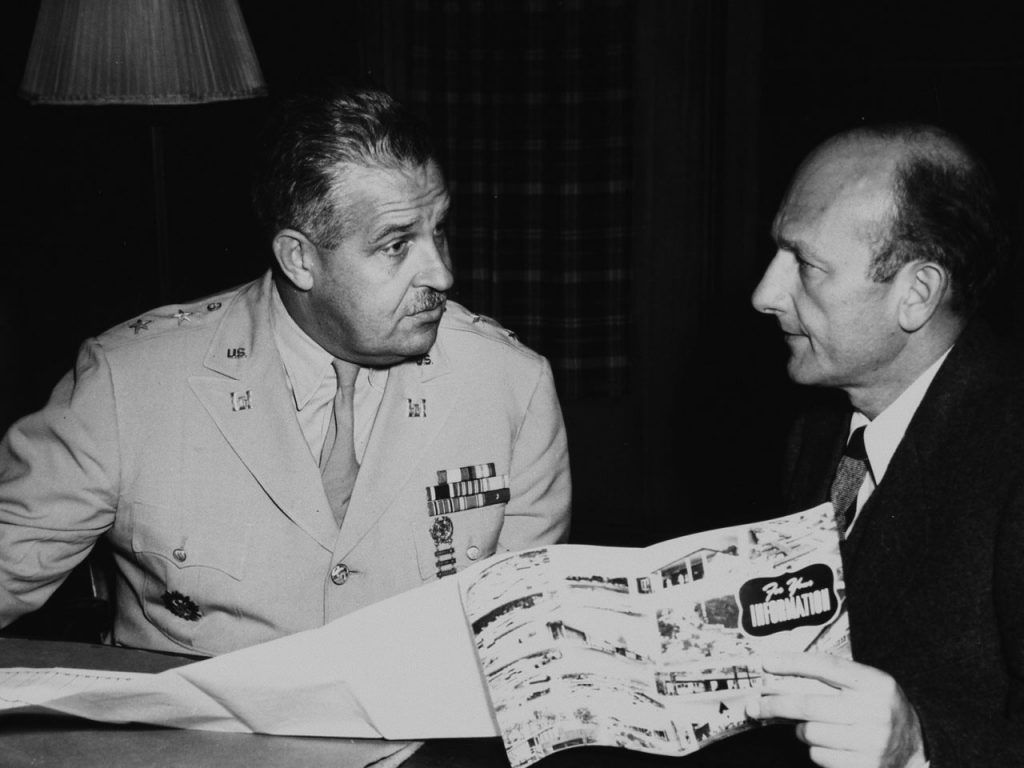David E. Lilienthal was the first Chairman of the Atomic Energy Commission (AEC). Prior to becoming the Chairman of the AEC, he served as the leader of a consultancy group for the State Department that was responsible for developing the Acheson-Lilienthal Report.
Chosen by Undersecretary of the U.S. Department of State Dean Acheson, Lilienthal led a special consultancy committee for developing a strategy for international control of atomic weapons. The other members of the committee were Chester Barnard, a telephone executive, Harry A. Winne, a Manhattan Project veteran and vice president of General Electric, J. Robert Oppenheimer, the “father of the atomic bomb,” and Dr. Charles Thomas, vice president of Monsanto and plutonium chemist (Neuse, p. 168-169).
Together, this group developed the Acheson-Lilienthal Report. Bernard Baruch, the United States representative to the United Nations Atomic Energy Commission (UNAEC), used the Acheson-Lilienthal Report to write his official proposal for the UNAEC. After the Soviet Union failed to accept the terms of Baruch’s proposal and the United States refused to compromise, discussions of positive international cooperation and arms control stalled in the UNAEC (Neuse, p. 175).
On October 28, 1946, Lilienthal was appointed as Chairman of the AEC by President Harry Truman. He did not take office, however, until January 1, 1947. According to The New York Times, his nomination was met with controversy from a variety of government officials, such as Senator Kenneth McKellar (D-TN), who insinuated that Lilienthal’s eastern European background meant Lilienthal “must be tainted with Communism.”
As Chairman of the AEC, Lilienthal attempted to bring atomic science into open debate and provide the public with access. To do achieve this openness, Lilienthal tried to minimize the need for excessive secrecy, which he thought could be destructive by forcing decisions to be made based on ‘caution, not justice‘ (Neuse, p. 230).
He also actively worked to ensure the American atomic bomb program remained in civilian hands rather than under the military’s control. Historian Alex Wellerstein argues that Lilienthal’s actions were rooted in his belief that “the military was more or less crazy-eager to use atomic bombs.” Throughout his career, Lilienthal and General Leslie R. Groves, the former Director of the Manhattan Project, butted heads. Groves told journalist Stephane Groueff that he felt Lilienthal “hated me like poison.”
Although Lilienthal’s personal convictions lay in international control of the atomic bomb, he realized the optimism surrounding world peace was fading by late 1947 and 1948 (Neuse, p. 199). During his time at the AEC, Lilienthal helped expand the stockpile of atomic bombs in the United States and encourage the use of nuclear fission in private industry.
Lilienthal opposed the crash hydrogen bomb development program. He reasoned that should the project fail, already scarce resources would be lost and the United States could fall behind in the production of atomic bombs. He retired from the AEC on February 15, 1950.
Early Years
David Eli Lilienthal was born in Morton, Illinois on July 8, 1899. Immigrating to the United States from Europe, his mother and father were originally from Slovakia and Hungary, respectively.
Lilienthal grew up in Indiana. In 1920, he graduated Phi Beta Kappa from DePauw University, where he also played varsity football for two years, boxed, and served as student body president.
Following DePauw University, Lilienthal attended Harvard Law School. He graduated with his J.D. in 1923. The same year, Lilienthal married Helen Marian Lamb, a fellow student from DePauw.
After passing the Illinois bar exam, he began to work for Donald Richberg’s firm in Chicago. At Richberg’s firm, he developed into a specialist in utility law. In considering his background in utility law and success as a special attorney for the city in a telephone-rate case, the State appointed Lilienthal to the State Utility Commission in 1931.
From the State Utility Commission, Lilienthal became the head of the Tennessee Valley Authority’s (TVA) power program. He was also the main negotiator for the TVA in purchasing Commonwealth and Southern properties.
On September 15, 1941, Lilienthal became the Chairman of the TVA. At the TVA, Lilienthal gained a reputation for challenging private power companies to lower their prices. He helped establish the TVA as a major source of electricity during World War II and the nation’s largest producer of electrical power by 1944.
Later Years
Following his retirement at the AEC, Lilienthal traveled around the country giving lectures on his life and work experiences. Later, he entered the private sector and became an industrial consultant at Lazard Freres and Company. The National Academy of Sciences awarded him the Public Service Medal in 1951.
In 1952, he became the president of Minerals Separation, an industrial minerals production company. A year later, Lilienthal joined the Development and Research Corporation and served as the company’s chairman and CEO. Harking back to his interests in utility development at the TVA, Lilienthal focused on dams, irrigation, flood control, and electrical generation.
Between the 1940s and 1980s, Lilienthal wrote several books. Some of the most well known include TVA: Democracy on the March (1944), This I Do Believe (1948), Big Business, A New Era (1953), and Change, Hope and the Bomb (1963). Lilienthal also kept a series of journals throughout his life. In his seven volumes of journals, Lilienthal detailed his inner thoughts and interpretations of his daily life, career, and global events.
At the age of eighty-one, Lilienthal died in New York City on January 15, 1981.
For more information about David E. Lilienthal, please see the following references:





